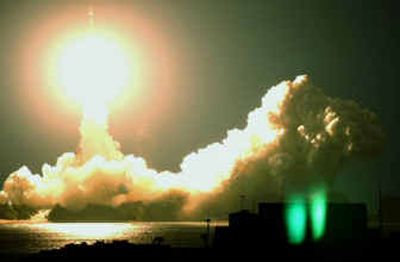Japan launches satellite

TANEGASHIMA, Japan – Fifteen months after a liftoff ended in a spectacular fireball, a Japanese rocket roared off its launchpad and placed a satellite in orbit Saturday, putting Japan back in the race with rival China to become Asia’s leading space power.
Domestically designed and built, the 174-foot-tall H-2A rocket is the centerpiece of Japan’s space program, and Saturday’s liftoff into a cloudy sunset from this remote southern Japan island was a major breakthrough for the relatively low-budget program.
Japan was the fourth country to launch a satellite, in 1972, and along with a major lunar exploration mission in the works now has a probe on its way to collect and retrieve samples from an asteroid – a mission that, if successful, would be a first.
But the midair explosion of an H-2A launched in November 2003 put Japan’s space plans on hold. Controllers had to detonate that rocket and its payload of two spy satellites after a booster failed to detach.
That setback came just one month after China successfully launched its first astronaut into orbit. Beijing has since announced it is aiming for the moon.
“We could not afford another failure,” Science Minister Naruaki Nakayama said after watching Saturday’s launch of the orange and white rocket. “My heart leapt when I saw the liftoff.”
Japanese officials say they are not in a space race with China. But in a major policy switch, a government panel last year recommended that Japan begin studying the possibility of establishing its own manned space program.
North Korea, meanwhile, has perhaps had an even deeper impact on Japan’s space program in recent years.
The perceived nuclear threat from the enigmatic communist nation, which launched a Taepodong 1 missile over Japan’s main island in 1998, has provided a strong impetus for Tokyo to beef up its space capabilities.
In a departure from its peaceful space policy, Japan launched its first spy satellites months before the 2003 failure as part of a $2 billion surveillance program.
Another set of spy satellites is now awaiting launch, though a date has not been set.
The program, while controversial in Japan and strongly condemned by Pyongyang, is not technically a military one. It is not paid for with military funds, and officials say it poses no threat to North Korea or any other nation.
Despite the influx of funds for spy satellites, officials at JAXA, Japan’s space agency, stress that Japan’s space program can only afford one or two launches a year with its $2.5 billion budget.
They say that is the main reason why Japan – despite being Asia’s richest and most technologically advanced nation – is falling behind China.
Still, officials have stressed that the H-2A has a relatively good – if not perfect – record.
The 2003 failure came after five straight successes, giving the rocket an 83 percent success rate. Europe’s Arianne 5 and China’s Long March 3 both have about an 85 percent success rate.
But Japanese hopes that the H-2A would become an attractive competitor in the commercial launching business have yet to pan out because of the rocket’s high cost and infrequent liftoffs.
JAXA Chairman Keiji Tachikawa said he believes Japan can compete, however.
“We could always reduce costs,” he said. “But what we really need to do is improve our reliability.”